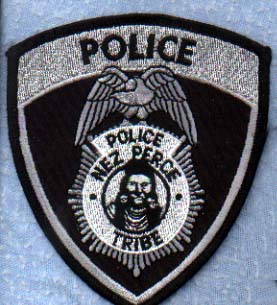Nez Perce Tribal Police Hosts First Multi-Jurisdictional Conference
The Nez Perce Tribal Police of Idaho hosted the first Multi-Jurisdictional Conference for Idaho on April 3–4, 2014. The purpose of the conference was to bring together the numerous jurisdictional entities that are on or near the Nez Perce Indian Reservation to identify problems and seek possible solutions to complex jurisdictional issues that challenge the region.
 The Nez Perce Indian Reservation is 1,200 square miles within the exterior boundaries of the 1863 Treaty. However the Dawes Act reduced tribal land ownership within the boundaries to approximately 144 square miles and opened the remaining 1,056 square miles to non-tribal settlement. Tribal lands and communities are scattered throughout the region in all five counties. This event created the extremely complex jurisdictional issues that the tribe, counties, and state are facing, issues that have placed public safety at risk.
The Nez Perce Indian Reservation is 1,200 square miles within the exterior boundaries of the 1863 Treaty. However the Dawes Act reduced tribal land ownership within the boundaries to approximately 144 square miles and opened the remaining 1,056 square miles to non-tribal settlement. Tribal lands and communities are scattered throughout the region in all five counties. This event created the extremely complex jurisdictional issues that the tribe, counties, and state are facing, issues that have placed public safety at risk.
There are five counties that have land within the boundary of the reservation, and one county is completely inside the boundary. At this time, there are no cross deputization agreements with any of the counties, and the state of Idaho does not recognize tribal police as peace officers within the state. The tribe does have a few MOUs in place for jail space and dispatch services. The tribe enjoys an excellent working relationship with the FBI and the U.S. Marshall's Service.
More than 300 people attended the conference, including various law enforcement representatives from throughout the region. Four of the sheriff's departments on the Nez Perce Reservation sent representatives, and two sheriffs made brief appearances at the conference. Greater attendance from the sheriff's departments was expected, and their few numbers demonstrate the ongoing problems of this region. In addition to the sheriff's departments' representatives from the Nez Perce Reservation, sheriffs that work with other tribes in the state of Idaho (Benewah County's Coeur d'Alene Tribe and Bannock County's Shoshone-Bannock Tribe) attended the conference.
The breakdown of agencies attending is as follows:
- Tribal police departments: 7
- Tribal governments: 7
- Tribal prosecutor offices: 5
- Non-government tribal agencies: 4
- County sheriff's deptartments: 9
- County governments: 0
- County prosecutor offices: 3
- City police departments: 4
- City governments: 2
- City prosecutor offices: 1
- State law enforcement agencies: 2
- State government: 2
- Federal law enforcement agencies: 6
- Federal government: 1
- Federal prosecution: 1
 David Rogers, chief of the Nez Perce Tribal Police Department, emceed the conference and presented his desired outcomes for the conference, which included both tribal and non-tribal participants: to enhance and encourage stronger collaboration and resource sharing with the multiple agencies within the Nez Perce Reservation. After the opening ceremonies, the conference began with welcomes from Silas Whitman, the Nez Perce tribal executive committee chairman. He was followed by Lawrence Wasden, the Idaho attorney general, and Wendy Olson, the U.S. attorney for the district of Idaho.
David Rogers, chief of the Nez Perce Tribal Police Department, emceed the conference and presented his desired outcomes for the conference, which included both tribal and non-tribal participants: to enhance and encourage stronger collaboration and resource sharing with the multiple agencies within the Nez Perce Reservation. After the opening ceremonies, the conference began with welcomes from Silas Whitman, the Nez Perce tribal executive committee chairman. He was followed by Lawrence Wasden, the Idaho attorney general, and Wendy Olson, the U.S. attorney for the district of Idaho.
The key plenary session was presented by presidentially appointed Commissioner Tom Gede of the Indian Law and Order Act Commission, who spoke on the national scope of tribal, federal, and state jurisdictional issues and addressed many of the recommendations the commission will be making to the President and Congress. His comment about returning to the pre-Oliphant decision and restoring full jurisdiction to the tribes with civil rights protections included and a new federal court of appeals caught the attention of everyone in attendance and sparked considerable discussion.
A discussion panel then took the stage to discuss what has worked in their respective areas. Sheriff Tom Allman of Mendocino County, California, presented on his challenges and successes in working with the COPS Office to create workable inter-agency agreements with several of the tribes in his county and the criticism he faced from other California sheriffs for his effort. Ultimately, he stated that creating those agreements is the right thing to do, that resource sharing provides better services to the community, and that these efforts enhance officer safety.
Also part of the discussion panel, Sheriff Rocky Watson of Kootenai County, Idaho, spoke about his development of a cross deputization agreements with the Coeur d'Alene Tribe that has proven to be successful and the challenges similar to Allman's that he too faced.
Chief Cody SiJohn of the Coeur d'Alene Tribal Police, Idaho, addressed the relationship the tribal police have with the Kootenai County sheriff and the struggles and successes they have had working with the Benewah County sheriff. The process is working, and the shared responsibility and resources has resulted in better service and protection to the overall community.
Last, Chief of Police Timothy Addleman of the Umatilla Tribal Police, Oregon, presented on a different approach that the state of Oregon took many years ago—to recognize tribal police as peace officers of the state and thus eliminate the need for ongoing efforts to cross deputize, which generally have to start over every time there is a new sheriff or new tribal police chief. Addleman reported that even the sheriffs who were most opposed to the new state law now agree that it is has been successful and should have been done earlier.
The audience then separated into two breakout groups: law enforcement and government. Each group was facilitated to discuss perceived or identified problems and issues as well as solutions to either reduce the problem or eliminate it all together. It became obvious throughout this process that even though the problems caused by agencies working independently have existed for many decades, many people do not have enough knowledge or education about the cause and effect of the history that led everyone to be at the conference. Participants quickly began to offer solutions, including strong and ongoing education and training for all involved governments and citizens alike.
Near the end of the day, Assistant United States Attorney Traci Whelan, speaking to the government group and Special Agent In Charge –Bureau of Indian Affairs Richard Melville in the law enforcement group addressed the Special Law Enforcement Commissions (SLEC) that have caused much concern on behalf of the sheriff's and county governments. This helped to inform the attendees on the intent of the SLECs, the ways in which they would be used, and that they aren't a threat to the existing powers of the sheriff or county governments.
The second day began with two plenary sessions. First, FBI-LEO Project Specialist Marcus Young spoke about his personal experience in an officer-involved shooting and about officer safety and the life-saving benefits of law enforcement agencies working together.
 Second, Washington State Senator John McCoy spoke on the bill that he introduced and that had passed the Washington State Legislature. This bill recognizes tribal police as state peace officers and gives them full police powers. He discussed the challenges he faced, but in the end, the need for public safety won despite politics and old histories and agendas. The success of the bill has been recorded in an ongoing nature, as reported by Tulalip Tribal Police Chief Carlos Echevarria, who spoke on how the Tulalip Tribe has been able to contribute to overall public safety in its region through strong collaboration and communication with its state and county counterparts.
Second, Washington State Senator John McCoy spoke on the bill that he introduced and that had passed the Washington State Legislature. This bill recognizes tribal police as state peace officers and gives them full police powers. He discussed the challenges he faced, but in the end, the need for public safety won despite politics and old histories and agendas. The success of the bill has been recorded in an ongoing nature, as reported by Tulalip Tribal Police Chief Carlos Echevarria, who spoke on how the Tulalip Tribe has been able to contribute to overall public safety in its region through strong collaboration and communication with its state and county counterparts.
Federal agencies then gave presentations on their roles in Indian country and the ways in which those roles relate to state and county law enforcement. Alex Claunts spoke on behalf of the U.S. Marshall's Office. Cori Marshall spoke on behalf of the U.S. Probation and Pre-Trial Service, and Justin Newsome from the FBI addressed his agency's role.
The short, afternoon breakout sessions focused on next steps and a request for participants to join the planning committee for the next Multi-Jurisdictional Conference, which will be held in 2015.
Ideas proposed and next steps included the following:
- Training for all agencies and communities on tribal, state, and federal jurisdiction
- Working toward cross-deputization agreements
- Working toward state recognition of tribal police
- Providing tribal cultural training to local law enforcement
- Holding more conferences to encourage dialog (many people thought this conference would consist of the tribe telling everyone else what to do, so many didn't attend)
- Doing officer exchanges by having them spend a week riding with the other agency
- Holding regular meetings between the agency heads of all the law enforcement on the reservation
- Including all community members in community police projects and not excluding anyone based on them being tribal versus non-tribal
- Collaborating together to identify areas where grants could be applied and where joint efforts could be made to solve or reduce problems
- Insuring that hiring and training standards are equitable with all agencies
- Sharing training with tribal and non-tribal agencies
- Maintaining open communication between agencies
Efforts are currently underway to plan the 2015 Multi-Jurisdictional Conference.
Chief David J. Rogers
Nez Perce Tribal Police Department
UAS Guidebook in Development | Reflections on the NIOT Gathering | Nez Perce Tribal Police Conference | LE Instructors and De-Escalation | Military and Law Enforcement | Hitting the Road with COPS
